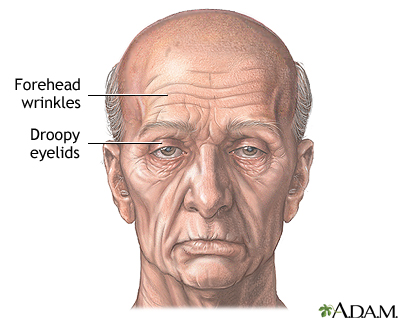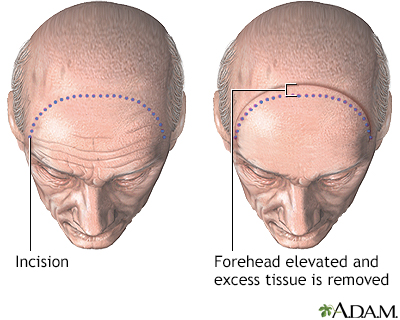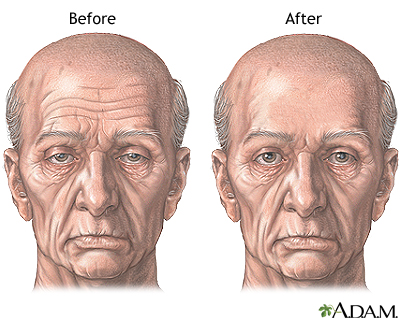Forehead lift - series

Indications
Forehead lifts are most commonly done for people in their 40s to 60s to slow the visible effects of aging.
In younger people, a forehead lift can raise congenitally low eyebrows that give the face a sad expression. In people whose brows are so low that they interfere with the upper field of vision, the forehead lift can be performed as a reconstructive procedure.
A good forehead lift candidate is someone who has one or more of these facial characteristics:
- Sagging brows
- Tissue that hangs down at the outer part of the eyelids
- Horizontal wrinkling on the forehead
- A dysfunctional nose
Deep furrows between the eyes also can be reduced through a forehead lift.

Procedure
Many surgeons used local infiltration anesthesia combined with a sedative, so the patient is awake but sleepy and insensitive to pain. Some patients request a general anesthesia, so they will sleep through the operation.
Sections of hair will be held away from the operative area. Hair immediately in front of the incision line may need to be trimmed but the head will not need to be shaved.
The incision is made at the level of the ears and continues across the top of the forehead at the hairline. This avoids making the forehead appear too high. If the patient is bald or balding, the surgeon may utilize a mid-scalp incision, eliminating a visible scar.
The forehead skin is elevated and measured for removal of excess tissue, skin, and muscle. The incision is closed with stitches or staples. This procedure may also be done using an endoscopic with a smaller incision.

Aftercare
The operative area is wrapped with a sterile padding and an elastic bandage to inhibit bleeding and edema. There will likely be numbness and temporary discomfort around the surgical site. These symptoms are easily controlled with medication.
The head should be elevated for two to three days after surgery to inhibit swelling. Bruising and swelling is inevitable around the eyes and cheeks, but this begins to disappear in about a week.
As the nerves regenerate, numbness of the forehead and scalp will soon be replaced with itching. It may take up to six months for these sensations to fully disappear. The bandages will be removed a day or two after surgery. Within 10 to 14 days, the stitches or clips will be removed.
Related Information
Forehead liftBACK TO TOP
Review Date: 12/31/2023
Reviewed By: Tang Ho, MD, Associate Professor, Division of Facial Plastic and Reconstructive Surgery, Department of Otolaryngology – Head and Neck Surgery, The University of Texas Medical School at Houston, Houston, TX. Also reviewed by David C. Dugdale, MD, Medical Director, Brenda Conaway, Editorial Director, and the A.D.A.M. Editorial team.

Health Content Provider
06/01/2025
|
A.D.A.M., Inc. is accredited by URAC, for Health Content Provider (www.urac.org). URAC's accreditation program is an independent audit to verify that A.D.A.M. follows rigorous standards of quality and accountability. A.D.A.M. is among the first to achieve this important distinction for online health information and services. Learn more about A.D.A.M.'s editorial policy, editorial process and privacy policy. A.D.A.M. is also a founding member of Hi-Ethics. This site complied with the HONcode standard for trustworthy health information from 1995 to 2022, after which HON (Health On the Net, a not-for-profit organization that promoted transparent and reliable health information online) was discontinued. |
The information provided herein should not be used during any medical emergency or for the diagnosis or treatment of any medical condition. A licensed medical professional should be consulted for diagnosis and treatment of any and all medical conditions. Links to other sites are provided for information only -- they do not constitute endorsements of those other sites. © 1997- 2024 A.D.A.M., a business unit of Ebix, Inc. Any duplication or distribution of the information contained herein is strictly prohibited.
